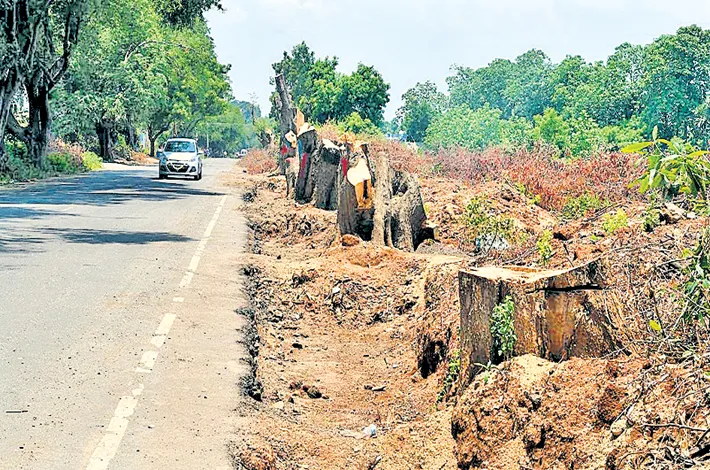40,000 trees cut down in Vijayawada
13-04-2025 12:00:00 AM

A healthy city should have at least 33% green cover. Today, Vijayawada is struggling at just 7%
KIRANMAI TUTIKA | AMARAVATI
Vijayawada is galloping with a slew of infrastructure development projects but in its march, the green cover is taking a beating. A healthy city should have 33% green cover but the city currently has just a meagre 7%. With projects like road widening, metro rail construction, and urban expansion accelerating over the past decade, the city’s greenery has shrunk dramatically—from 9% in 2014 to just 7% today.
Since the bifurcation of Andhra Pradesh in 2014, Vijayawada—being one of the key urban hubs in the reorganized state—has undergone a massive transformation. According to data from local environmental activists and municipal sources, nearly 40,000 trees have been cut down in and around the city in the name of development.
Ch. Narayana, a prominent environmentalist, remarked, “A healthy city should have at least 33% green cover. Today, Vijayawada is struggling at just 7%. This is an ecological emergency, not just a statistic.” Iconic roads such as Bandar Road, Eluru Road, and BRTS Road—once canopied by dense tree lines—have become stark stretches of concrete and asphalt. Neighbourhoods like Satyanarayanapuram, Ayodhya Nagar, Governorpet, Suryaraopeta, and Guru Nanak Colony, which were once shaded with thick foliage, are now witnessing a near-total loss of greenery.
A prime example is Pinnamaneni Polyclinic Road, which previously boasted 400 to 500 trees along its 2-kilometre stretch. Most of these trees have now been axed for road widening. “There’s hardly any space left for fresh plantations, as roads have been extended end-to-end with little regard for green buffers,” noted a civic official.
The Metro rail project has added another blow to the city’s ecology. Over 700 trees near Benz Circle were axed to make way for metro pillars and infrastructure back in 2017. Even Mahatma Gandhi Road, known for its lush central divider plantations, is set to lose hundreds more trees as it falls under the proposed metro corridor, which will soon take place.
A senior official from the Vijayawada Municipal Corporation (VMC), speaking on condition of anonymity, admitted that the most severe loss of greenery occurred during 2015 and 2016, driven by administrative expansion and Krishna Pushkaralu. Citizens are expecting even in the upcoming Pushkaralu, a few more trees might be axed. “Pushkaralu saw thousands of trees removed to make way for temporary infrastructure and crowd management. Our focus was traffic and public convenience, not environmental balance,” said N. Bhaskar, a VMC official.
With the rapid replacement of independent homes by high-rise apartments, many backyard trees—like mango, coconut, and guava—have disappeared. It is estimated that residents alone have chopped down over 10,000 trees to accommodate modern housing styles. “Until a few years ago, every house had a few fruit trees. Now it’s just ornamental plants in balconies,” laments V. Sumathi, a long-time resident of Suryaraopet.








